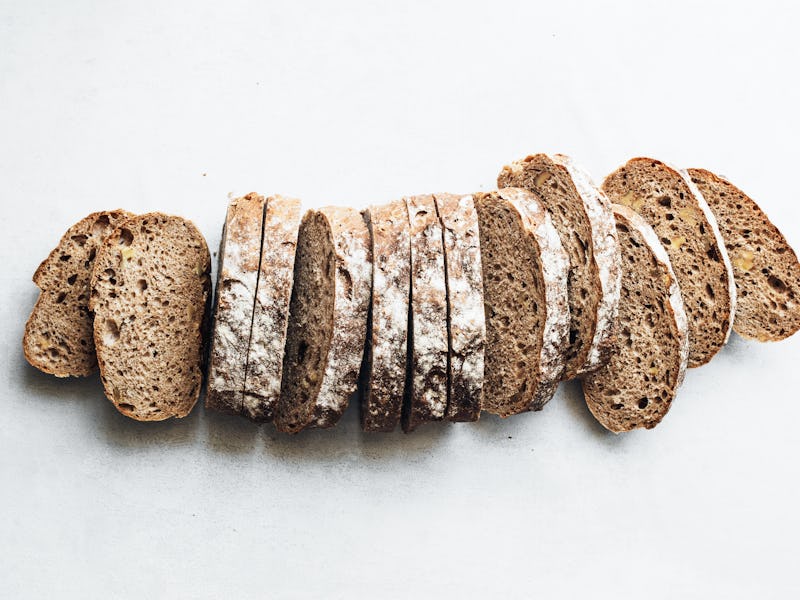Multigrain, Whole Wheat, Wholegrain: Which Bread Is Healthiest for You and Why
Not all breads are created equal.

Whole wheat, wholegrain, multigrain, sourdough, rye, white, high fiber white, low GI, low FODMAP, gluten-free. With so many choices of bread available, how are we to know which is best for our health?
Bread has always been a dietary staple in households. It’s a good source of carbohydrate, it’s low in fat, and whole grain varieties are a good source of protein, fiber, vitamins, and minerals, as well as healthy fats.
Whole grains are high in dietary fiber, which helps keep us feeling full. Diets high in whole grains are linked to a reduced risk of health conditions such as excess weight and obesity, heart disease, type 2 diabetes, and some cancers. Dietary fiber is also beneficial for bowel health by preventing constipation and feeding the “good” gut bacteria, which is likely to result in a number of health benefits. A study found a diet high in whole grains was associated with a lower risk of bowel cancer.
Due to the grains being ground down during processing, white and whole wheat breads have a higher glycemic index (GI) than whole grain bread, which results in glucose being released into the bloodstream more quickly. Regular consumption of lower GI foods helps to regulate blood glucose levels, keeping us fuller for longer and helping us eat fewer calories to keep our weight in check.
White bread is made from wheat that has had the germ and bran removed, thereby reducing the fiber, B group vitamins, vitamin E, and minerals such as iron, zinc, magnesium, and phosphorus.
Whole Wheat
Whole wheat bread is made from whole grains that have been milled to a fine texture, giving a plain brown appearance. Whole wheat flour contains more fiber than white flour. Whole wheat bread also contains more vitamins and minerals than many white breads, but has a higher GI than whole grain breads.
Multigrain
Often multigrain bread is made from white flour with some added grains. Despite this, multigrain breads tend to have more fiber and a lower GI than white bread, resulting in longer lasting energy.
Whole Grain
Breads that use whole grain are best.
Whole grain bread contains the entire grain: the bran (outer layer), endosperm (starchy middle layer), and germ (nutrient-rich inner part). It’s a rich source of carbohydrates, protein, unsaturated (good) fats, vitamins, and minerals, as well as three types of fiber: soluble, insoluble, and resistant starch. Whole grain bread has a dense whole wheat flour base and well as lots of grain and seeds. Look for “whole grain” in the ingredient list.
Soy and linseed bread has the added benefit of healthy omega 3 fats. Whole grain bread is low GI as are whole wheat breads with added grains.
Rye
Rye bread has a heavier texture due to a lower gluten content (but it’s not gluten-free). Whole grain rye with added grains has a higher fiber and vitamin content than light rye and has a lower GI, as does rye sourdough. Whole grain rye is a good choice for health, and even light rye is better than white.
Sourdough
Sourdough bread has a lower GI due to the higher acidity level. Fiber, vitamin, and mineral levels vary with the flour used, with whole grain sourdough being the preferred choice. Be sure to choose an authentic sourdough, as some are faux sourdough and contain yeast rather than the traditional starter.
Authentic sourdough takes a long time to produce and results in an acidic and chewy bread, two features that lower the GI. Look for a chewy texture and the absence of yeast in the ingredients, preferably with whole wheat flour or rye whole wheat, grains, and seeds.
High Fiber White
High fiber white breads are white breads that have fiber added to them. This makes them a better choice than regular white bread, especially for children (or big kids) who won’t eat whole grain bread.
Gluten-Free
Gluten-free breads are made from an alternative grain to wheat, so as to avoid the wheat protein gluten. Traditionally, gluten-free breads have had a lower fiber content and higher GI than their wheat-containing counterparts, although, there are now some with added seeds.
These breads are useful for people with a gluten intolerance such as coeliac disease but offer no additional health benefits beyond regular breads for the rest of us.
Low FODMAP
Similarly, low FODMAP breads have recently hit the market. These breads are suitable for people such as those with irritable bowel syndrome (IBS), who are sensitive to a group of carbohydrates known collectively as FODMAPS. FODMAPS are found in a number of foods, including wheat. These breads still contain gluten and are not suitable for people with celiac disease.
Although better than regular white bread, as they contain seeds and grains, the fiber content varies between brands, so people without sensitivities are generally better to choose whole grain breads.
Not all breads are created equal. Ideally, look for heavy, dense breads with lots of grains and seeds. Ingredient lists on food labels are written in descending order, so look for words such as whole grain, kibbled grain, nuts, and seeds at the beginning of the ingredients list. Foods with more than 4g of fiber per serving are considered a good source of fiber under the Australian food standards code.
Go for a whole grain, whole grain rye, or authentic sourdough breads (particularly rye or grain sourdough). The soft, fluffy white breads are best left for the occasional Bunnings sausage sizzle, where the only decision to make is onions or no onions.
This article was originally published on The Conversation by Leah Dowling. Read the original article here.